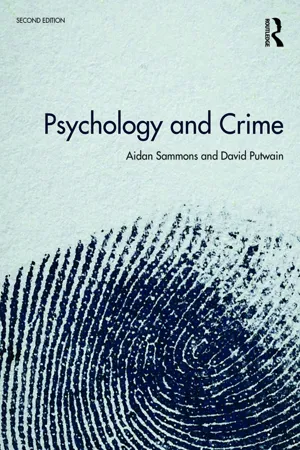Psychology
Biological Explanations for Bullying
Biological explanations for bullying suggest that genetic, neurological, and hormonal factors may contribute to aggressive behavior. Research has shown that certain genetic variations and imbalances in neurotransmitters, such as serotonin and dopamine, may be linked to an increased likelihood of engaging in bullying. Additionally, differences in brain structure and function, as well as hormonal influences, have been implicated in aggressive behaviors.
Written by Perlego with AI-assistance
Related key terms
Related key terms
1 of 4
Related key terms
1 of 3
6 Key excerpts on "Biological Explanations for Bullying"
- eBook - ePub
Cyber-Bullying
Issues and Solutions for the School, the Classroom and the Home
- Shaheen Shariff(Author)
- 2008(Publication Date)
- Routledge(Publisher)
There are some who suggest that nature and nurture both affect bullying. Biology and the social, family and educational environments students experience are the primary forces involved in bullying. Genes, hormones, personality traits or physiological impairments occurring during pregnancy or early infancy, can significantly affect later development. As Boyd observes, ‘What’s bred in the bone will come out in the flesh’ (2000, p. 95). Seven years later, we can now add: ‘What’s bred in the bone will come out in physical and virtual flesh’, as kids take on new personalities in cyberspace. Environmental influences can be considered the ‘nutritional elements’ that interplay to result in positive or negative behaviours. It is important to look at the biological and environmental factors in schools, in the home and in cyberspace that affect student identities, attitudes about themselves, and behaviour towards others. Understanding how these factors affect students helps us understand how and why bullying of any kind occurs.Scholarship on bullying in the last two decades has largely defined it as a ‘developmental’ problem—focusing on aggressive tendencies or behaviour of individual ‘bullies’ and suggesting that those individuals need ‘intervention’ or ‘treatment’. In other words the matter has been studied, and still continues to be from a paradigmatic, psychological perspective, as a health issue. This is slowly changing as developmental psychologists and other researchers globally have begun to realize the importance of context.It is important, nonetheless, to briefly highlight some of the biological influences that might make a difference in whether or not a student engages in bullying, becomes constantly targeted as a victim, or stands by as an observer.Biological factors, including genetics, hormones, allergies, overactive thyroids, attention deficit disorders and other physiological influences, can influence young children’s propensity to bully. Children who exhibit chronic behaviour problems from biological sources comprise approximately 6 per cent of the school population (NCPC, 1997; Shariff, 2000, May). Two major sources of concern here are nutrition and medication. Research tells us, for example, that substance abuse and lack of nutrition during pregnancy or the pre-school years impair the growth of brain cells and that fetal alcohol syndrome (FAS) affects one-third of young offenders (NCPC, 1997). A number of researchers found that violent offenders have distinct personality traits that originate in early childhood, such as hyperactivity, impulsivity, poor concentration, an inability to defer gratification and low empathy. Others have found these traits remain constant through to adulthood (Reiss, et al., 1993).1The Olweus (2001) international study on bullying corroborates these studies. He found that bullying behaviour starts early and persists into adulthood.2 - eBook - ePub
School Bullying
Teachers helping students cope
- Phillip Slee(Author)
- 2016(Publication Date)
- Routledge(Publisher)
Volk et al. (2012) also distinguish between bullying and general aggression, noting that while all bullying is aggression, not all aggression is bullying. They also distinguish between types of bullying, namely ‘pure bullying’ and ‘bully-victims’, noting that the reactive aspect of bully-victims suggests that bullying in this instance may be the result of dysregulative behavior. The writings of Freud described earlier in this chapter have some interesting parallels with ethological theory.In summary, in proposing an ethological theoretical lens for bullying it may be regarded as an adaptive response in the competition for resources, dominance and survival and intended to provide an overall benefit to its users.Biology and bullying
Vaillancourt et al. (2013) reviewed research in the areas of neuroscience, neuroendocrinology and genetics providing strong and convincing evidence for why and how the effects of bullying can last a lifetime. Their review concluded that bullying impacts on the brain in the same manner that a physical pain does, resulting in dysregulation of the nervous system’s neuroendocrine response to stress. Moreover, certain genetic profiles place bullied children at greater risk for poorer sequelae, including a risk of life-long mental and physical health problems.The field of neuroscience is a multi-disciplinary one (being essentially a subdivision of biology) and offers an exciting insight into the nature and impact of school bullying. Simply put, neuroscience is the study of how the nervous system develops, its structure, and what it does. Neuroscientists focus on the brain and its impact on behavior and cognitive functions. Not only is neuroscience concerned with the normal functioning of the nervous system, but also what happens to the nervous system when people have neurological, psychiatric and neurodevelopmental disorders. Shalev et al. (2013) noted the increasing interest in discovering the mechanisms that mediate exposure to childhood stress and later-life disease, and highlighted the role of telomere erosion. Simply described, telomeres are a region of repetitive DNA at the end of a chromosome, which protects the end of the chromosome from deterioration. That is, on the end of every animal’s chromosomes are protective caps called telomeres. Without them our chromosomes would become unstable. Each time a cell divides it never quite copies its telomere completely and throughout our lifetime the telomeres become shorter and shorter as the cells multiply. Eventually, when they become critically short, we start to see age-related diseases, such as cancer. In their study Shalev et al. (2013) looked at telomere erosion as related to violence exposure (domestic violence, frequent bullying and physical maltreatment) in young children aged 5 years and re-assessed at 12 years. The findings indicated that compared with their counterparts those children who had experienced two or more kinds of violence exposure showed significantly more telomere erosion between the baseline assessment at 5 years and at follow-up at 12 years. The implications of this finding relate to later-life vulnerability to health-related problems associated with exposure to the cumulative exposure to violence (e.g. bullying) in early life. - eBook - ePub
- Michele Harway, James M. O'Neil(Authors)
- 1999(Publication Date)
- SAGE Publications, Inc(Publisher)
Concurrently, there are many angry people who do not have a significant psychological pathology. Hamberger and Hastings (1986) found that 15% of their sample of domestic violence offenders showed no evidence of psychopathology. Approximately 25% of the Greene, Coles, and Johnson (1994) sample had subclinical scores on their measures of pathology. Interpersonal violence is obviously multidetermined and occurs in individuals with and without significant psychopathology.Although a host of theories exists regarding the underlying dynamics of family violence (see Feldman & Ridley, 1995, for a review), integrative explanatory characterization of the full range of psychobiological theories of violence is only beginning to emerge. Rosenbaum, Geffner, and Benjamin (in press) have proposed a biopsychosocial model of relationship aggression, which includes arousal, threshold, and high habit strength factors as contributors to aggression. Risking oversimplication, Greene, Lynch, Decker, and Coles (1997) have suggested that personality features and psychobiology may be predictably related in domestic violence. O’Neil and Harway (1997) proposed several content areas and hypotheses related to domestic violence that need to be explored. They organized their content areas into macrosocietal; biological, neuroanatomical, and hormonal; gender-role socialization and gender-role conflict; and inter-gender relational explanations. They further differentiated their hypotheses within each content area into predisposing and actual triggering hypotheses.The purpose of this chapter is to describe current research regarding psychobiological intra-individual determinants of battery, aggression, and violence. Specifically, O’Neil and Harway’s (1997) biological, neuroanatomical, and hormonal content area hypotheses will be addressed in this chapter. The two hypotheses are these:Hypothesis 4: Testosterone or hormonal levels in men contribute to violence toward women.Hypothesis 5: Neuroanatomical differences or other biological factors in men produce men’s tendency to be violent toward women.There is little support for the hypothesis that hormones predispose men to batter, although other endocrine functions may contribute to violence. In contrast, the data are somewhat convincing that for a certain percentage of cases, abnormal brain functioning is the predisposing factor, not the actual triggering event. This review will be organized into five sections: (1) genetic theories, (2) endocrine theories, (3) neurotransmitter theories, (4) brain dysfunction theories, and (5) summary. - Richard West, Christina S. Beck(Authors)
- 2018(Publication Date)
- Routledge(Publisher)
Let’s follow Volk’s (1995) logic and think about “bullying” as a kind of metapattern that occurs, albeit in different forms, across physical, biological, ethological, physiological-psychological, and cultural systems. Hurricanes seek warm water. Diseases seek healthy cells. Animal predators seek food. But what are bullies after? Researchers show that children (ages 8–12) who bullied were motivated in part by a desire to increase their popularity (a kind of power) as evidenced by choosing unpopular victims (Veenstra et al., 2005). “Bullies aren’t looking to be loved … they are looking to be noticed” (Boyles, 2015, p. 1844). Of course, hurricanes, infectious diseases, and animal predators must do as nature dictates. They find a host, take what they need, and continue to do so until conditions change such that a host can no longer can support them or until the host is destroyed. Hurricanes, diseases, and animal predators (as well as human bullies) interact with the outside world, forming a metapattern that is characterized as parasitic (Volk, 1995). That is, when conditions are favorable, hurricanes, diseases, animal predators, and human bullies alike, unable to exist (or achieve needs-satisfaction) without a host, successfully penetrate a host’s borders and form a parasitic bond. More specifically, human bullies seek out host-persons (victims) who appear weak, and when conditions are right, engage in bullying communication, inflict damage, and continue to do so until the conditions that gave rise to bullying are depleted and/or otherwise are no longer available (e.g., see Veenstra et al., 2005). Akin to the biology and chemistry of hurricanes, diseases, and animal predators, human bullies may possess genetic predispositions that can give rise to and influence bullying behaviors (for aggression, see Bandura, 1973; and see the communibiological approach in McCroskey & Beatty, 2000). However, unlike hurricanes, diseases, and animal predators, human bullies are also conscious and social beings who, in non-clinical populations, have the capacity to reflect on, halt, and/or change their patterns of behavior.Thus, bullying communication can be conceptualized as a dark-side, developmental, and lifespan communication phenomenon that involves the strategic use of various forms of aggressive messages for specific purposes with specific targets in specific conditions forming parasitic bonds between bully and victim. However, what might these specific purposes, targets, and conditions be? And what does bullying communication look like in its earliest, most primitive forms?Parameters of Bullying Communication and Childhood
According to Greene (2000), researchers who study human bullying agree on the following five necessary conditions for bullying to exist:- The bully intends to inflict harm or fear upon the victim.
- Aggression toward the victim occurs repeatedly.
- The victim does not provoke bullying behavior by using verbal or physical aggression.
- Bullying occurs in familiar social groups.
- The bully is more powerful (either real or perceived power) than the victim.
Motivating Conditions
With respect to bullying communication, motivating conditions can include an intent to inflict harm (psychological, physical), intimidation, and/or to frighten someone in service of needs-satisfaction for attention and control (Veenstra et al., 2005). However, it is important that we draw additional distinctions when it comes to the motivations of children considered clinical (i.e., requiring psychiatric and psychological care) versus non-clinical as well as motivations to engage in acts of bullying that are criminal.- eBook - ePub
- Joan McCord(Author)
- 2017(Publication Date)
- Routledge(Publisher)
Hence, the biological paradigm of human behavior is most useful when looking at how such environmental influences as isolation, neglect, abuse, and other conditioning variables are imprinted into individuals to cause predictable, incorrigible behavioral disorders years later. So biological psychiatry does not contradict any of the conclusions of other fields as to the importance of contextual variables on personality and behavior; it simply addresses the possibility that these conditioning experiences are mediated into long-ranging behavior through known and newly discovered biological and neurobiological systems. Indeed, many of the animal models of behaviors hypothesized to be related to psychopathy, such as aggressiveness, fit a social interaction paradigm. Therefore, a useful scheme for integrating these viewpoints is to segment the complex construct of antisocial behavior to consider it a composite of more easily investigated factors such as arousal, dominance, and aggression. Each of these component factors has been studied in humans using a dimensional model of personality traits leading to interesting hypotheses about the relationship between psychosocial variables, neurobiological function, and personality. The structure of this paper will be to report on studies of impulsivity and related traits, such as sensation seeking and extroversion, as well as presenting important studies on human aggressiveness. Finally these two sets of findings will be integrated to organize a conceptual heuristic for exploration of models of sociopathy. 1 Arousal models of psychopathic behavior The classic neurobiological explanation of criminal behavior suggests that individuals prone to engage in nonconforming, impulsive, or rule breaking behavior have low levels of baseline “arousal” in some central arousal system - eBook - ePub
Psychology and Crime
2nd edition
- Aidan Sammons, David Putwain(Authors)
- 2018(Publication Date)
- Routledge(Publisher)
Chapter 5 ). In the 1990s there was a resurgence of interest in biological factors and there is now widespread acknowledgement that theories of offending that do not incorporate them are necessarily incomplete. This chapter starts by reviewing evidence for some of the biological differences that have been found between offenders and non-offenders and outlining their putative role in criminal behaviour. There follows a discussion of where these differences may come from, focused on a selection of possible causes: genetics, environmental pollution, traumatic brain injury and adverse childhood experiences.Biological differences between offenders and non-offenders
The biological view assumes that an individual’s behaviour is organised by his nervous system, particularly his brain, and criminal acts are a consequence of this. Biopsychology does not claim that there are specific brain areas or processes that cause people, for example, to burgle houses, file false tax returns or assault their spouses. Rather, an offender’s nervous system interacts with social and other environmental influences to give rise to tendencies to behave in particular ways (e.g. aggression) that become criminal acts when they violate the law. Biopsychological research has tended to focus on aggressive crime as it is relatively straightforward to identify (unlike, say, financial fraud), is a pressing social problem and has clear links to the large and well-researched body of biological knowledge about aggression. This makes it an obvious target for researchers wishing to investigate biological influences on offending.Low heart rate
One of the most consistent findings in the biopsychology of offenders is that they have a lower heart rate than non-offenders. The association is remarkably robust and is found in children, adolescents and adults and across different cultures (Portnoy & Farrington, 2015). Low heart rate (LHR) can predict aggression and conduct problems in children and violence in adults independently of other variables such as personality and family history (Farrington, 1997). What is not clear is why offenders have LHRs. One possibility is that LHR indicates a chronically low level of activity in the nervous system. The individual finds this uncomfortable and offending provides risk and excitement, thereby raising their arousal level to a more comfortable level (the sensation-seeking hypothesis). A second possibility is that LHR reflects a diminished capacity to experience fear. Since fear, intuitively at least, plays a part in stopping people from acting on their antisocial impulses then fearless people might be more prone to offending (the fearlessness
Index pages curate the most relevant extracts from our library of academic textbooks. They’ve been created using an in-house natural language model (NLM), each adding context and meaning to key research topics.
Explore more topic indexes
Explore more topic indexes
1 of 6
Explore more topic indexes
1 of 4





